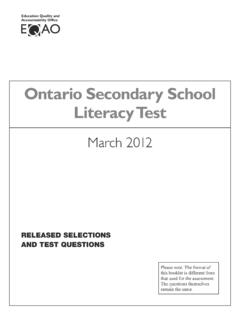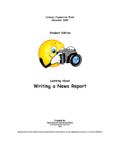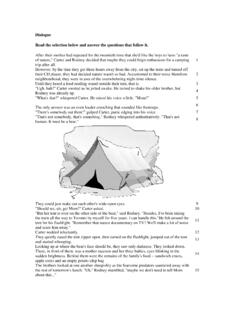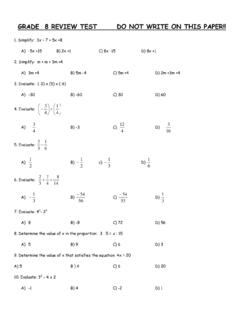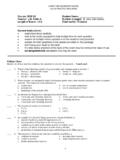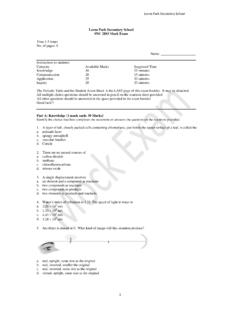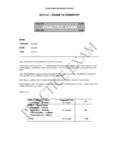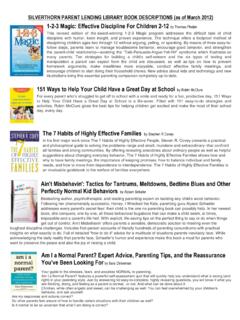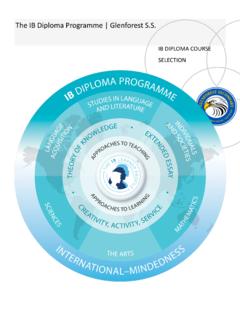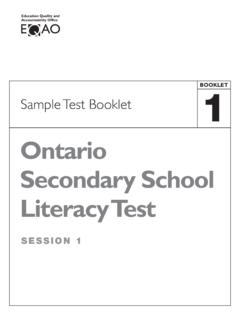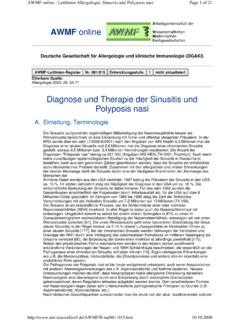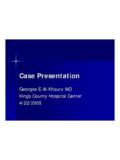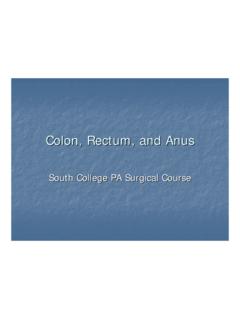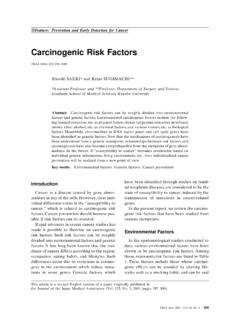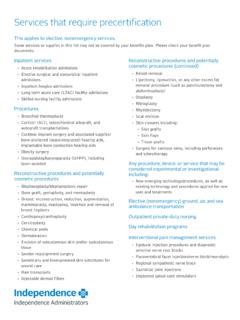Transcription of Lorne Park Secondary School Mock Exam Time: 1.5 …
1 Lorne Park Secondary School Mock Exam Time: hours Teachers: Ms. Hutson & Ms. Vanstone Part A True/ False and Multiple Choice 55 marks Allow 50 min Part B Short Answer and Problems 35 marks Allow 40 min Part A True/False Indicate whether the sentence or statement is true or false. ____ 1. Cells having a nuclear membrane surrounding a well-defined nucleus are classified as prokaryotic cells. ____ 2. Plant and animal cells contain all of the same cytoplasmic organelles. ____ 3. Meiosis is a process by which gametes are formed. ____ 4. In humans, the haploid number of chromosomes is 46 and the diploid chromosome number is 23. ____ 5. All daughter cells produced by meiosis are genetically identical to each other and to the parent.
2 ____ 6. In snapdragons, red-flowering plants combine with white-flowering plants to produce pink-flowering plants. This is an example of codominance. ____ 7. It is possible to have more than two alleles for one gene. ____ 8. The probability of two heterozygous individuals having an offspring heterozygous for that gene is 1/2. ____ 9. The cardiac sphincter is at the end of the stomach located closest to the esophagus. ____ 10. An open circulatory system is more efficient in delivering oxygen to cells than a closed circulatory system. ____ 11. The semilunar valves are located between the atria and the ventricles. ____ 12. Air moves into the lungs from outside the body when air pressure within the lungs is less than the atmospheric pressure.
3 ____ 13. The internal intercostal muscles pull the rib cage downward when you are inflating a balloon. ____ 14. Viruses are not represented in the six-kingdom system because they do not exhibit enough different characteristics for scientists to classify them. ____ 15. Cephalochordata and Urochordata do not have backbones or vertebral columns despite being members of the chordates. ____ 16. The egg-laying mammals are the marsupials. Modified True/False Indicate whether the sentence or statement is true or false. If false, change the identified word or phrase to make the sentence or statement true. ____ 17. Adaptations are any characteristics that allow an organism to reproduce more successfully.
4 _____ ____ 18. Sharks, snakes, and crocodiles are able to grow new teeth all of their lives. This is considered to be an example of analogous structures. _____ ____ 19. There are a great variety of breeds of dogs. This is considered to be an example of natural selection. _____ ____ 20. A single species may change through time to become another species. _____ Multiple Choice Identify the letter of the choice that best completes the statement or answers the question. ____ 21. Energy released during cellular respiration is stored in a compound called a. glucose. d. DNA. b. ADP. e. RNA. c. ATP. ____ 22. At what organelle are amino acids bonded together?
5 A. endoplasmic reticulum b. nucleus c. vacuole d. ribosome e. amino acids are not bonded at an organelle ____ 23. The organelle responsible for storage and packaging of proteins is the a. nucleus. d. vesicle. b. ribosome. e. Golgi apparatus. c. endoplasmic reticulum. ____ 24. If a cell with 36 chromosomes undergoes mitosis, each daughter cell will have a. 36 chromosomes. d. 9 chromosomes. b. 72 chromosomes. e. 6 chromosomes. c. 18 chromosomes. ____ 25. Which cells in the human body have a diploid number of 46 chromosomes in their nuclei? a. all cells b. only the reproductive cells c. only cells that are produced by meiosis d. only zygotes e.
6 Only cells that are produced by mitosis ____ 26. The term "phenotype" may be defined as a. genes on the Y chromosome. b. the genetic makeup of the individual. c. genes on the X chromosome. d. the gene pool expression of a population. e. an observable expression of genotype. ____ 27. In the cross of Tt Tt, the proportion of the offspring that will have the same genotype as the parents is a. 25%. d. 100%. b. 50%. e. none of the above. c. 75%. ____ 28. To determine if an organism with a dominant phenotype is heterozygous, the organism is mated to an individual that is a. heterozygous for the trait in question. b. homozygous recessive for the trait in question.
7 C. homozygous dominant for the trait in question. d. of the same genotype as the organism being tested. e. opposite to the genotype as the organism being tested. ____ 29. The rare trait called ocular albinism (almost complete absence of eye pigment) is inherited as a sex-linked recessive trait. A man with ocular albinism marries a woman who is a carrier of this condition. Which of the following is the best prediction concerning their offspring? a. All their children of both sexes will have ocular albinism. b. All their sons will have ocular albinism, and all their daughters will be carriers. c. About half the sons and half the daughters will have ocular albinism, the other half of the sons will have normal eyesight, and the other half of the daughters will be carriers of the condition.
8 D. None of their children will have ocular albinism, but all their daughters will be carriers. e. None of the above ____ 30. Familial intestinal polyposis results in multiple fingerlike growths (polyps) from the lining of the large intestine. It is inherited as a dominant trait. Let P represent the allele producing the polyps and p represent the normal allele. One parent is Pp and the other pp. If the couple has four children, how many would be expected to have the familial intestinal polyposis phenotype? a. 1 d. 4 b. 2 e. 0 c. 3 ____ 31. In which of the following lists are the events listed in the sequence in which they actually occur? a.
9 Ingestion, absorption, digestion, egestion b. ingestion, digestion, absorption, egestion c. absorption, ingestion, egestion, digestion d. absorption, digestion, ingestion, egestion e. digestion, ingestion, absorption, egestion ____ 32. Which of the following is not found in digestive fluids in the stomach? a. hydrochloric acid d. amylase b. pepsinogen e. mucus c. pepsin ____ 33. Which of the following enzymes breaks down fats? a. amylase d. lipase b. maltase e. dissacharidase c. trypsin ____ 34. What is the role of the bicarbonate ion in the digestive process? a. to initiate the digestion of starches b. to emsulsify fats c. to lower the pH of material entering the small intestine from the stomach d.
10 To raise the pH of material entering the small intestine from the stomach e. to stimulate the release of gastric juices ____ 35. Which of the following is not a type of white blood cell? a. basophil d. monocyte b. eosinophil e. platelet c. lymphocyte ____ 36. Which of the following is true of arteries? a. They always carry oxygenated blood. b. They always carry deoxygenated blood. c. They are the site of exchange of materials between the blood and the tissues. d. They always carry blood away from the heart. e. They always carry blood toward the heart. ____ 37. Which of the following correctly outlines the pathway that is followed by a red blood cell that first enters the heart at the vena cava?
